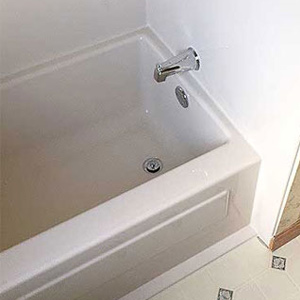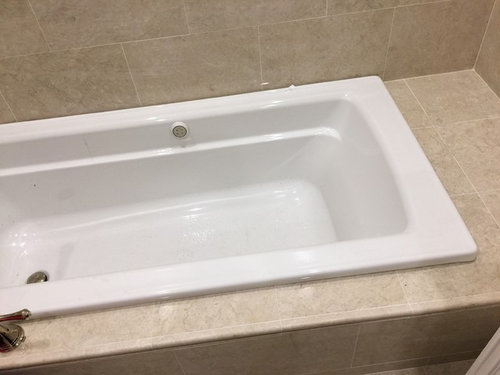The Fundamentals of Plumbing Skills for Bathtub Installation
The Fundamentals of Plumbing Skills for Bathtub Installation
Blog Article
In this article in the next paragraph you can get more really good news on the subject of A Step-by-Step Guide to Installing a Bathtub.

Installing a bath tub isn't specifically brain surgery, yet it does need solid plumbing, carpentry, as well as often, tiling abilities. Changing an old bath tub with a new one is also a moderately challenging project. If the old bathtub is conveniently available, the project can move easily; if you need to open up a wall surface to eliminate the old bathtub and position the new tub, the job is much harder. In either case, the project is within a house handyman's abilities, although you will certainly require an assistant to vacate the old tub and embeded in the new one. Make certain you have actually qualified on your own for the task as well as are comfortable trying it. As opposed to hiring a specialist to take control of a halfway-completed project, it is far better to take into consideration using one prior to you begin. Opportunities are you may require a specialist plumber to make tube connections.
This short article will assist you set up a brand-new bathtub in your shower room if you have actually currently gotten a brand-new tub as well as don't need to alter the plan of your previous water pipelines.
Your tools as well as material checklist should comprise the following:
Removing Old Taps
If you need to change old taps with brand-new ones as a part of your setup, after that the first thing you must do is detach the supply of water. After doing so, activate the taps to drain any type of water continuing to be in the system. The process of eliminating the existing faucets can be quite troublesome as a result of the limited access that is frequently the situation.
Make use of a container wrench (crowsfoot spanner) or a tap tool to undo the nut that connects the supply pipes to the faucets. Have a cloth all set for the remaining water that will come from the pipes. When the supply pipes have been removed, make use of the very same device to loosen up the nut that holds the faucets onto the bath/basin. You will certainly require to quit the single taps from turning during this procedure. When the taps have been removed, the holes in the bath/basin will certainly need to be cleaned up of any old securing compound.
Prior to moving on to fit the new taps, compare the pipe links on the old taps to the brand-new taps. If the old faucets are longer than the new faucets, then a shank adapter is required for the brand-new faucets to fit.
Fitting New Touches
If the tails of the new taps are plastic, after that you will require a plastic connector to avoid damage to the thread. One end of the adapter fits on the plastic tail of the tap and the other end gives a connection to the existing supply pipelines.
If you require to fit a monobloc, then you will call for reducing couplers, which attaches the 10mm pipe of the monobloc to the typical 15mm supply pipeline.
Next, position the tap in the installing hole in the bath/basin making certain that the washing machines are in location between the tap as well as the sink. Protect the faucet in place with the manufacturer given backnut. Once the tap is safely in position, the supply pipes can be linked to the tails of the taps. The taps can either be connected by utilizing corrugated copper piping or with normal faucet adapters. The previous type should be attached to the faucet ends initially, tightening up just by hand. The supply pipes can later be attached to the other end. Tighten up both ends with a spanner after both ends have actually been linked.
Installing the Bath tub
Using both wooden boards under its feet, put the bathtub in the needed position. The wood boards are useful in equally spreading the weight of the bathtub over the location of the boards instead of focusing all the weight onto 4 small points.
The following objective is to guarantee that the bathtub is leveled all round. This can be attained by examining the spirit level and also readjusting the feet on the tub until the level reads degree.
To set up faucets, fit the bottom of the furthest adaptable tap adapter to the suitable supply pipeline by making a compression join; after that do the same for the various other faucet.
Activate the water as well as check all joints and new pipework for leaks and tighten them if required. Fill the bathtub as well as additionally inspect the overflow outlet and the regular electrical outlet for leaks.
Finally, deal with the bathroom paneling as described in the manufacturer's instruction manual. Tiling and also sealing around the bath tub must wait until the bath tub has been made use of a minimum of once as this will certainly settle it into its final setting.
Planning for the Installment
To start with, the sustaining framework supplied with the bath should be fitted (if called for) according to the supplier's guidelines. Next, fit the taps or mixer to the bath tub. When suitable the tap block, it is essential to ensure that if the tap comes with a plastic washing machine, it is fitted between the bathroom as well as the taps. On a plastic bathroom, it is also reasonable to fit a supporting plate under the faucets system to prevent pressure on the tub.
Fit the adaptable tap adapters to the bottom of the two faucets using 2 nuts as well as olives (sometimes supplied with the tub). Fit the plug-hole outlet by smearing mastic filler round the sink outlet hole, and afterwards pass the outlet with the hole in the bathroom. Make use of the nut supplied by the maker to fit the plug-hole. Analyze the plug-hole outlet for an inlet on the side for the overflow pipeline.
Next, fit the end of the flexible overflow pipeline to the overflow electrical outlet. After that, screw the pipe to the overflow face which must be fitted inside the bath. Make certain you make use of all of the supplied washing machines.
Link the catch to the bottom of the waste outlet on the tub by winding the string of the waste electrical outlet with silicone mastic or PTFE tape, and screw on the trap to the electrical outlet. Connect the bottom of the overflow tube in a similar manner.The bath must now prepare to be suited its last position.
Tiling Around the Bathtub
In the location where the bathroom meets the floor tile, it is essential to seal the joins with a silicone rubber caulking. This is important as the fitting can move sufficient to break an inflexible seal, creating the water to penetrate the wall between the bathroom and also the tiling, bring about difficulties with wetness and also feasible leaks to the ceiling listed below.
You can pick from a selection of coloured sealants to assimilate your components and fittings. They are marketed in tubes as well as cartridges, as well as are capable of securing gaps approximately a width of 3mm (1/8 inch). If you have a larger gap to fill up, you can load it with spins of drenched newspaper or soft rope. Remember to always load the bathtub with water before sealing, to enable the activity experienced when the tub is in use. The sealant can break relatively early if you do not think about this activity prior to securing.
Additionally, ceramic coving or quadrant tiles can be made use of to border the bathroom or shower tray. Plastic strips of coving, which are easy to use as well as cut to size, are additionally quickly offered on the marketplace. It is recommended to fit the floor tiles using water-resistant or waterproof glue as well as grout.
Bathtub Installation
How Important Is A Bathtub To Your Home?
High-quality baths, showers, and other bathroom updates are necessary when considering a smart investment in your home. It’s a room that you go to every day and one that is constantly being used by guests.The bathroom is one of the top trafficked rooms in a home and also one of the most valuable in terms of home resale.
Install Piping Before Tub
You will be using your existing drain and waste vent system, but pipes required include the hot and cold water supply lines and a pipe leading to a shower head. A mixing valve and shower head are also needed. Air chambers may be required.
Position the Tub
Lower the tub into place so that the continuous flange fits against the wall studs and rests on 1’x4' or 2’x4' supports. Anchor the tub to the enclosure with nails or screws inserted through the flanges into the studs.
NOTE: Remember, bathtubs and shower stalls may require support framing. A bathtub filled with water is extremely heavy, so check building codes and framing support before installing the tub.
Assemble Drain Connections
Assemble the bathtub drain connections by connecting the tub overflow with the tub drain above the trap, not beyond it. The trap will have a compression fitting that screws over the arm of the overflow assembly.
Place a Pipe For the Shower Head
First, locate a brass female threaded winged fitting and attach it to a framing support via a screw or a nail. Then run a pipe up the wall for the shower head. Sweat or solder the other side of the brass fitting to the top of the pipe.
Attaching Hot and Cold Water Lines
Attach your water lines for both hot and cold by sweating these directly into the hot and cold ports of the mixing valve. The mixing valve will be how water enters the tub’s system, not by the pipes themselves.
Install the Spout
Extend a piece of 1/2 inch pipe, or whichever length is specified in the manufacturer’s instructions, for the tub spout. Sweat on a male threaded fitting at the end of the pipe or use a brass nipple of the proper length and a 1/2 inch cap.
NOTE: At this point you should have your rough-in plumbing work inspected before proceeding further.
Check For Leaks
Restore the water pressure and check the drain connection and the supply pipes for any sign of leaking.
estore the Bathroom Wall
Replace the wall with moisture-resistant drywall as a base for your wall covering. Seal the joints between the wall and your new tub with silicone caulk as protection against water seepage.
https://www.berkeys.com/2016/12/02/bathtub-installation-dallas/

As a serious person who reads on A Step-by-Step Guide to Installing a Bathtub, I thought sharing that piece of content was important. Sharing is caring. Helping people is fun. Bless you for your time. Kindly stop by our blog back soon.
Plumbing emergencies? Our experts await. Report this page